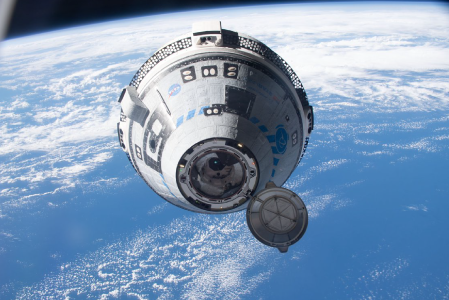Boeing is on course to reignite American human spaceflight with its CST-100 Starliner, a 21st century space capsule that will take people to and from low-Earth orbit.
Here are nine reasons why the Starliner will be something to watch in 2018:
1. The Starliner will lead in space exploration.
The first flight of the space capsule will be a major milestone in the return of human spaceflight for America. The last time humans lifted off from American soil was in 2011, and being able to transport crews safely, reliably and affordably is strategically important for the United States to remain the global leader in space exploration.
2. It will reignite the industry.
While final assembly and launches of the space capsule will take place in Florida, there are production, integration and test activities happening right now all across America. Boeing is breathing new life into the aerospace industry, and the Starliner’s economic impact can be seen across the U.S. with more than 400 supplier companies in 38 states.
3. It will enhance space research.
The Starliner will allow additional astronauts to work aboard the International Space Station conducting research across many scientific disciplines. With a full crew of seven astronauts aboard the station, plus the space capsule’s capability to bring 220 pounds of equipment and cargo to the station, the orbiting laboratory will greatly increase its ability to perform experiments on new technologies and help find potential cures for diseases.
4. The Starliner will launch atop America’s most reliable rocket.
Boeing designed the Starliner to be compatible with a variety of rockets and selected the United Launch Alliance (ULA) Atlas V to launch the initial test flights and missions. The Atlas V has unmatched past performance and unparalleled schedule assurance. With more than 70 launches at 100 percent mission success, the Atlas V rocket provides Boeing and NASA a wealth of data to glean from for human certification.
5. The Starliner will mark many firsts.
For the first time in history, a space capsule built in the U.S. will be certified to land on solid ground rather than in the ocean. The Starliner features parachutes and an airbag landing system that will absorb the shock of impact with the ground while protecting the crew members inside. The Starliner also can be reused as many as 10 times — another first for a space capsule — thanks to a weldless pressurized crew cabin. This will reduce manufacturing costs by extending the life of the spacecraft.
6. It incorporates cutting-edge technology.
The Starliner features its own spacesuits, modern displays, tablets, 3D printed parts and wireless internet. For example, the award-winning “Boeing Blue” spacesuit is 40 percent lighter than older spacesuit models. With enhanced mobility, innovative layers to keep astronauts cool and touchscreen-friendly gloves, this suit is tailor-made for the Starliner.
7. It can be configured for crew or cargo.
The Starliner was designed to accommodate as many as seven passengers or a mix of crew and cargo. For NASA missions to the International Space Station, the spacecraft will carry as many as five passengers — four NASA astronauts with room for a fifth paying passenger. This flexibility allows for a variety of missions to destinations in low-Earth orbit.
8. The Starliner can fly itself.
From launch to landing, the Starliner will fly completely on its own. Autonomous flight, including rendezvous and docking, is the next logical step for human spaceflight, allowing the spacecraft’s crew members, ground and mission teams and space station crew to focus on other tasks, such as performing groundbreaking research.
9. The Starliner makes space more accessible than ever before.
NASA is Boeing’s flagship customer for the Starliner, beginning with missions to and from the International Space Station and carrying NASA and NASA-sponsored astronauts. As new opportunities, new destinations and new markets emerge in low-Earth orbit, the Starliner will transport a variety of passengers, including international and corporate astronauts, scientists, researchers, educators and even tourists.
Read More:
Vice President Pence Takes a Peek at Boeing’s Starliner Spacecraft
